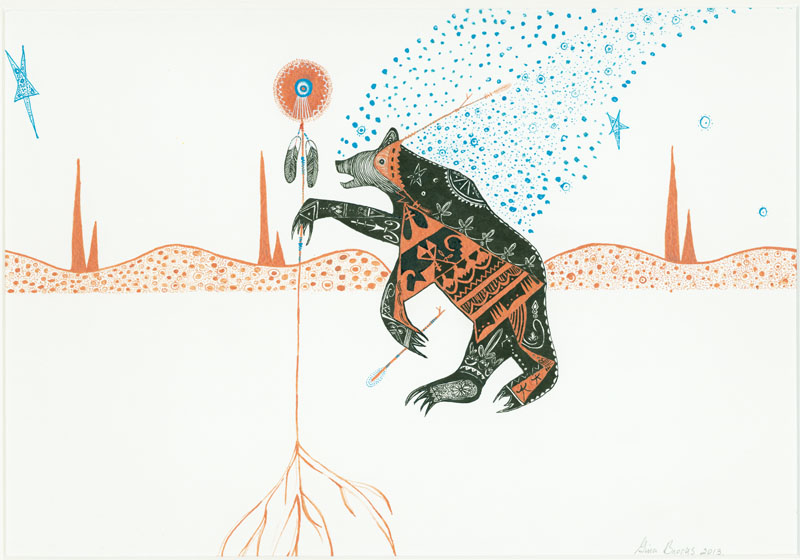TWISTED PATH III: QUESTIONS OF BALANCE
Begun in 2008, the Abbe Museum’s “Twisted Path” series seeks to describe “the complex cultural pathways that contemporary Native American artists explore through creative expression.” This ambitious third installment features sculpture, photography, painting, textiles, video, pottery, jewelry and mixed-media work by nine artists from tribes in the Northeast, Southwest, Pacific Northwest and Canadian Maritimes.
The opening image, Auto Immune Response #5, 2005, is a large-scale color photograph of two men wearing respirator-like devices standing before a decimated landscape. This evocation of post-apocalyptic survival, one of several in the show by Will Wilson, a member of the Diné (Navajo) people, might lead one to substitute “imbalance” for “balance” in the exhibition’s subtitle.

Gina Brooks, Muwin (Bear), 2013, pen and ink on paper, 16 x 20″. Collections of the Abbe Museum. Photo courtesy of the Abbe Museum.
Rick Hunt, an Abenaki, offers another compelling health-related image, Balance: Diabetes, 2013. The acrylic and black fabric paint on paper montage includes used insulin needles (the artist’s own), affixed to the surface to create a headdress on the portrait of a chief. As Hunt explains in a statement, diabetes “runs rampant” in tribal communities. The lives of Native Americans are thrown off balance “by the things that society insists we partake of through obnoxious and assaultive advertising.”
Questions of cultural identity take center stage in the work of Tlingit/Aleut artist Nicholas Galanin. Things Are Looking Native, Native’s Looking Whiter, 2012, is a digital print that seamlessly combines a Native American subject by 19th-century photographer Edward Curtis with a photograph of actress Carrie Fisher as Princess Leia in Star Wars. Both figures wear the traditional butterfly whorl hairstyle associated with unmarried Hopi girls and appropriated by George Lucas.
Taos Pueblo artist Patricia Michaels dresses four mannequins in found object garments, provoking a variety of narratives. In Read Head, 2013, a figure wearing a dress made of newspapers reads a copy of the Santa Fe New Mexican that includes a feature story about Michaels being the first native artist chosen for Project Runway.
Not all the work in the show co-curated by Hunt, and Raney Bench and Julia Clark for the Abbe Museum, is political. Yet even Passamaquoddy Gabriel Frey’s handsome brown ash pack basket underlines the crucial role traditional arts continue to play in sustaining the cultural balance of the tribes.
